EMT / ASELSAN Tufan rail implement project (Turkey)
The Turkish rail cannon development program, suitable for various applications, was launched in 2014 year. As part of the research and development work under the name of EMT (Elektromanyetik Top) it was supposed to study the existing problems, determine the prospects for unusual weaponsand also find the most convenient options for the architecture of the finished system. According to the results of these works, it was necessary to create and submit for testing, first bench samples, and then full-fledged gun systems suitable for mounting on carriers.
ASELSAN, a leading Turkish developer and manufacturer of military products, has undertaken the main research and development of advanced weapons. In addition, according to various data, some subcontractors were involved in the work, the task of which was to carry out certain ancillary works. To date, the Turkish defense industry has completed some stages of the EMT program and even brought it to the testing stage of the first prototypes and the construction of new samples.
According to reports, as early as 2015, ASELSAN obtained the first results, and also issued patents for some original designs. After this work continued and led to the emergence of an experienced gun, designed for bench tests. This product was built last year, and in December made the first test shots. It is reported that successful tests bench model will continue to work and eventually create an artillery system suitable for use by the armed forces.
The first prototype of the ASELSAN EMT system was tested in the last days of December 2016. Five shots were performed, demonstrating the fundamental success of the program. In addition, this check allowed us to establish the approximate characteristics of the existing sample. According to the company-developer, in the course of further development, the Turkish gun was supposed to show the highest characteristics. The initial velocity of the projectile was supposed to bring to 2-2,5 km / s, which allowed to get the firing range at the level of 300 km.
After carrying out the first pilot shooting, the project continued to develop. Having identified the main features of the technical appearance of the artillery unit, the company-developer began to create other elements of the promising complex. To date, at least, the bulk of this work has been successfully completed. Thanks to this, ASELSAN was able to build a prototype suitable for the first public demonstration. The venue for such a “premiere” of a promising EMT project was the IDEF 2017 exhibition, which took place in Istanbul in May.
In the pavilion of the international military technical salon, a new prototype rail tool, created as part of an ongoing program, was presented. This product received its own designation ASELSAN Tufan ("Flood" or "Flood"). Unlike the previous model, such an artillery complex is made in the form of a relatively compact system of tower layout. This architecture indicates the possibility of using weapons by the armed forces. First of all, such a complex may be of interest to the naval forces and become weapons of warships.
A curious feature of the Tufan prototype is the relatively simple design of external parts and assemblies that cover the main devices from external influences and prying eyes. All important devices are placed inside the enclosures and hulls, which, apparently, can be made of armor steel and provide protection from retaliatory shelling. In this case, the shape of the body can speak about the application of some known developments in the so-called. stealth technology. Typical chopped enclosures can be designed to properly reflect and redistribute radar signals.
In general, the Tufan combat module, equipped with a rail gun, consists of three main blocks of a large size. The first is the supporting device. Probably, a relatively large polygonal unit should be mounted directly on the deck of the carrier ship. It is distinguished by a small height and has front, side and aft parts installed at different angles to the vertical. On the sides and stern there are hatches for access to the internal equipment. The roof of the support element of the complex has a shoulder strap for mounting a full turn tower. Apparently, for the horizontal pickup of the gun, performed by turning the entire tower, electric drives with remote control are used.
The tower of the Tufan system received a cap of a rather complex shape. At the same time, as follows from its appearance, all the necessary units are placed inside such a case, and in addition, they are provided with fairly easy access to them for maintenance. The frontal part of the tower consists of several surfaces installed at different angles to the longitudinal axis, vertical and to each other. In this case, the front of the tower received a large vertical cut-out for mounting the rocking artillery unit.
The sides of the tower are based on a pair of large panels, and the front has a large opening for mounting a double hatch. The front panels of the sides are installed with the collapse outward, while the rear panels, on the contrary, converge. The stern of the tower is formed by a medium-sized niche above and a wedge-shaped lower unit. In the panels of the latter there are two more large hatches.
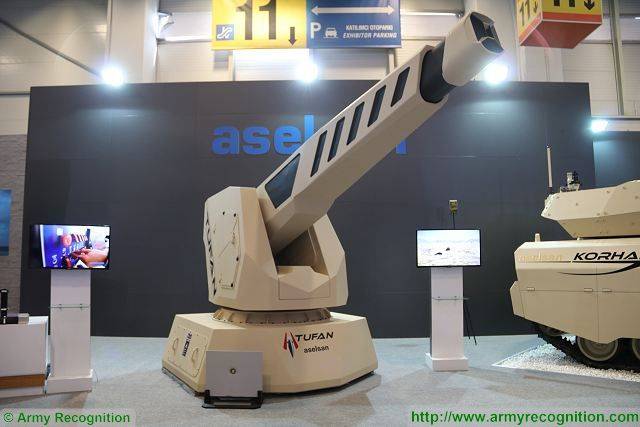
Sample after exhibition opening
Directly rail gun made in the form of the main element of the swinging artillery units. In addition to it, the assembly of this unit includes fastening means and a casing of a characteristic shape. The muzzle of the "trunk" is covered with a casing of oval section with triangular grooves on the front end. The back of this casing is bevelled. Behind the bevel there is an oval casing of a reduced section, behind which is a larger body. This element of protection covers almost all of the gun, from the breech and to the muzzle covers. It differs in the increased sizes and the changing section in the form of polygons of the different size. Trunnion mounting artillery units, apparently, are at the level of the side hatches of the tower.
Detailed information about the design of the rail tool has not yet been announced, but even without them, we can draw some conclusions. Almost along the entire length of the swinging part, two guide rails pass, which are necessary to disperse the ammunition. Apparently, the Tufan project offers horizontal placement of these parts - above the “bore” and under it. Certain materials on the project suggest that rails with a curved working surface are used. In the stern of the turret, probably, there is a certain system of supplying ammunition to the barrel. It is possible that in a developed feed niche there are mechanized stowages for the automatic supply of ammunition. In this case, as follows from the principles of operation of the instrument, the complex only needs to store projectiles, since it does not need any containers with a propelling charge of a chemical type.
As part of the EMT program, ASELSAN has developed a new ammunition for a promising weapon. The use of ready-made shells for a variety of reasons is not possible, which required the creation of a specialized shot. Due to the characteristic features of the rail guns, in addition to the projectile, it was necessary to develop special equipment to ensure its correct acceleration.
Actually, the Tufan projectile is a metal “blank” of large elongation, about half of the length of which falls on the lively head fairing. The rear half of the body has a cylindrical shape. Stabilization of the projectile due to rotation, attached to the rifling of the barrel, by definition, is impossible, because of which in the tail section of the projectile provides a plane-stabilizers of small scope. Such a projectile weighs about 7 kg. It is possible to create ammunition for various purposes, differing from each other in the type of warhead.
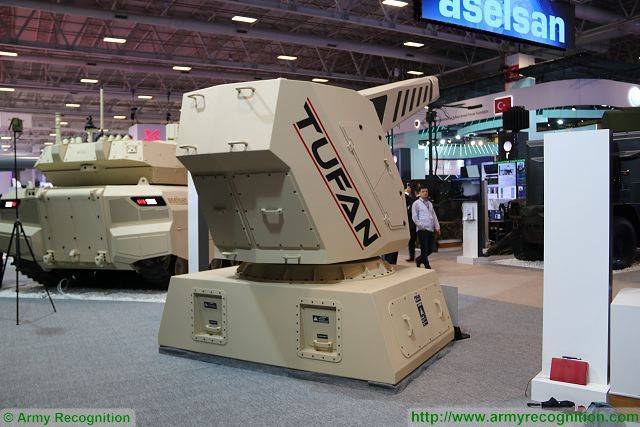
Rear view
For the correct passage of the projectile along the “barrel” of the rail gun, special leading devices were developed. In the desired position, the ammunition is held by a special plastic dielectric tray. It consists of two parts, fastened together. Assembling the pan has the shape of a cylinder with an internal cavity under the projectile, and on its outer surface there are two rectangular protrusions that perform the functions of the leading belts. Behind the pan of the projectile is mounted an additional part-pusher, which provides acceleration of the shot. This device is made of metal and has a rather complex shape. When fired, concave surfaces should interact with the guide rails, and the front end should push the pan with the projectile.
By the principle of operation, the product ASELSAN Tufan is no different from other developments of its class. With the help of automation, the complex should place a shot in the collection on the rails, after which the remote-controlled drives should perform a tip-off. The shot is made by applying a current to the rails from a high power source. As a result, the Ampere force accelerates the pusher along the rails, and that, in turn, transmits the impulse to the pallet with the projectile. After passing through the muzzle, the pallet is separated, and then the projectile is sent to the target. The pusher detail is likely to partially burn out during acceleration and then its remnants fall to the ground or into the water.
It is reported that a promising Turkish-developed weapon is capable of showing a muzzle energy of 14 MJ, which is at least not worse than the characteristics of modern tank guns. According to available data, the existing 7-kg projectile accelerates to speeds of about 2 km / h. At such an initial speed, the ammunition will be able to hit the target at ranges of at least 32 nautical miles. Thus, in terms of a number of basic characteristics, the "Flood" complex has noticeable advantages over existing shipborne artillery systems.
A characteristic problem of rail guns and other systems that use electromagnetic effects, is a significant consumption of electricity. The required power of the ASELSAN Tufan complex was not specified. Knowing the peculiarities of foreign developments of this kind, it can be assumed that the carrier of such a system should receive sufficiently powerful generators and other means necessary for supplying a current with the required characteristics to the rails. It is possible that the use of such devices will not lead to a noticeable gain in overall dimensions or weight in comparison with existing artillery systems of traditional design.
In its current form, the Tufan gun mount can give the ship carrier some new features. For example, it is possible to optimize the use of internal volumes of the hull and superstructure due to the refusal of shells with a propelling charge and the absence of the need to locate the tower and the cellar in the immediate vicinity. In addition, starting with a certain size of ammunition, a complex with a rail gun is more compact and easy. From the point of view of fire characteristics, such as muzzle energy or firing range, the rail gun looks like the most serious “powder” systems of modern models.
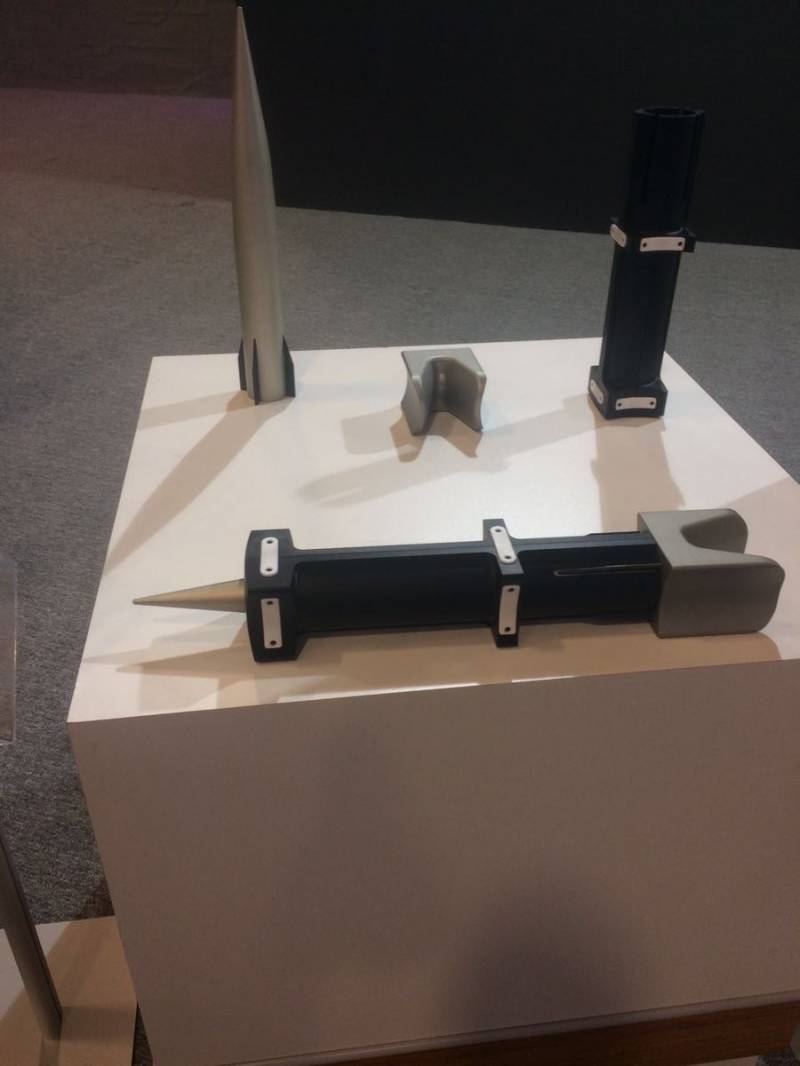
Ammunition for guns Tufan. In the background, a projectile, a pusher and a pallet; in the front - a shot in the assembly
At the same time, a number of problems of weapons of this class have not yet been resolved, and it is unlikely that they will be able to get rid of in the near future. From the traditional artillery complex ASELSAN Tufan and others like him are more complex and expensive to manufacture. In addition, the advantages in the form of high energy and high-velocity projectile are compensated by the low mass and, as a result, the insufficient power of the ammunition. The shot form factor proposed by the Turkish gunsmiths imposes serious restrictions on the mass of the warhead.
It should be noted that the further development of the projectile can have a decisive influence on the future of the entire project. In connection with the rise in the cost of exploitation and the increase in the cost of an individual shot, there is a sense in creating guided ammunition. However, the limited size and weight are unlikely to successfully solve this problem while maintaining acceptable fire characteristics and achieving the desired power. The project risks falling into a difficult situation when the availability of controls will reduce the effectiveness of the fire, increasing the warhead will make the projectile heavier and reduce its initial speed, and in the end all this will lead to the loss of real advantages over the traditional gunpowder artillery.
Presented at the recent IDEF 2017 exhibition, the ASELSAN Tufan artillery system, equipped with a rail gun, is intended for installation on modern and promising medium and large displacement warships, which can also carry the necessary power supplies. Will it be possible to bring the project to the installation of guns on the test ships or even to full operation fleet - for now, one can only guess.
Meanwhile, the development of the Elektromanyetik Top program continues. Specialists of ASELSAN and subcontractors continue to study various aspects of electromagnetic artillery and to identify further ways of its development, as well as to determine the necessary refinements of existing structures. The plans of the Turkish industry in this context have already been announced. The desired output of the EMT program is as follows. The military and industry want a large-caliber rail gun suitable for use on land or at sea. This system will have to accelerate the ammunition to speeds of at least 2 km / s and send it to a distance of 300 km. The possibility of creating new ammunition for various purposes, including those equipped with guidance systems, is not excluded.
Whether the Turkish engineers will be able to solve all the tasks and give the armed forces a fundamentally new weapon is not yet known. However, the very existence of the EMT program and the recently introduced prototype Tufan demonstrates some very interesting things. The project and the sample show that not even the most industrially developed countries are able to study promising areas and even show some success. Nevertheless, the possibility of developing these successes and bringing new developments to practical application may face certain doubts. And yet, even with ambiguous prospects, the current brave Turkish project is of great interest.
On the materials of the sites:
http://armyrecognition.com/
http://hurriyetdailynews.com/
https://dunya.com/
http://milliyet.com.tr/
http://kokpit.aero/
http://strangernn.livejournal.com/
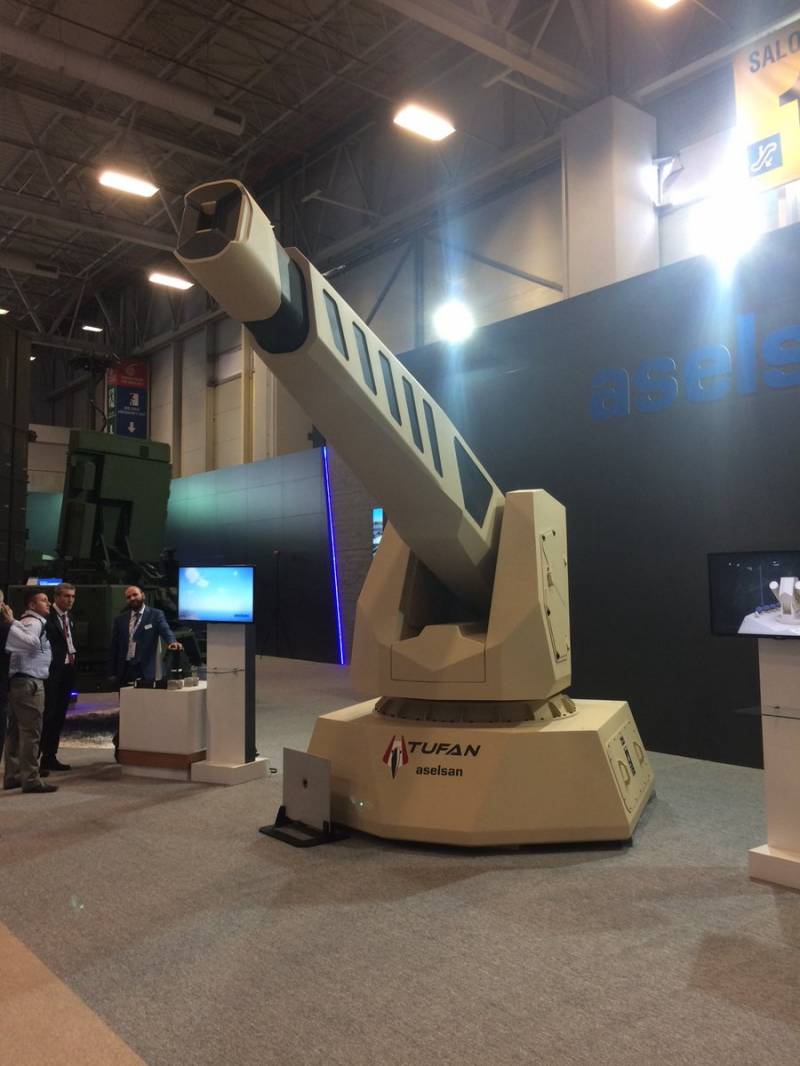
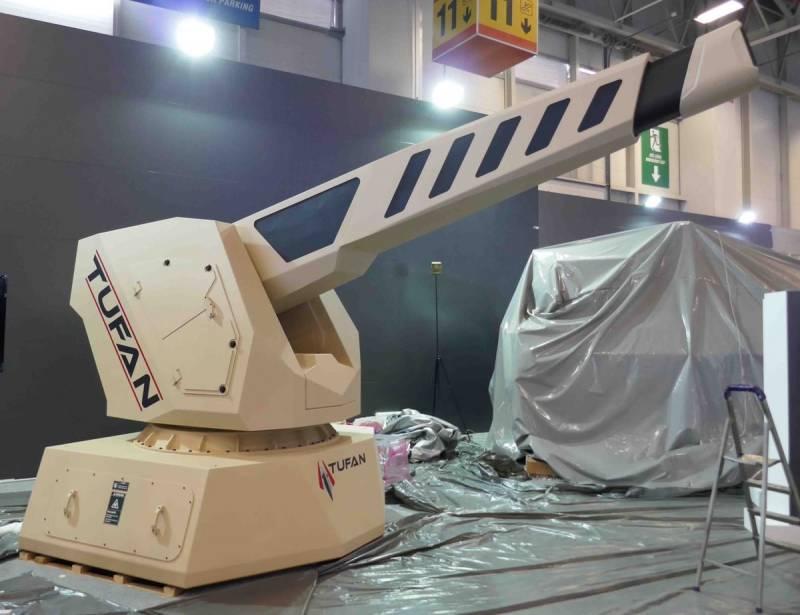
Information